Get free scan and check if your device is infected.
Remove it nowTo use full-featured product, you have to purchase a license for Combo Cleaner. Seven days free trial available. Combo Cleaner is owned and operated by RCS LT, the parent company of PCRisk.com.
What is Quasar?
The Quasar tool allows users to remotely control other computers over a network. Software programs of this type are known as remote access tools (RATs). There both are legitimate and illegal RATs. Quasar is a legitimate tool, however, cyber criminals often use these tools for malicious purposes.
I.e., to steal personal information that could be used to generate revenue. If you suspect that Quasar is installed on the operating system (unintentionally), remove it immediately.
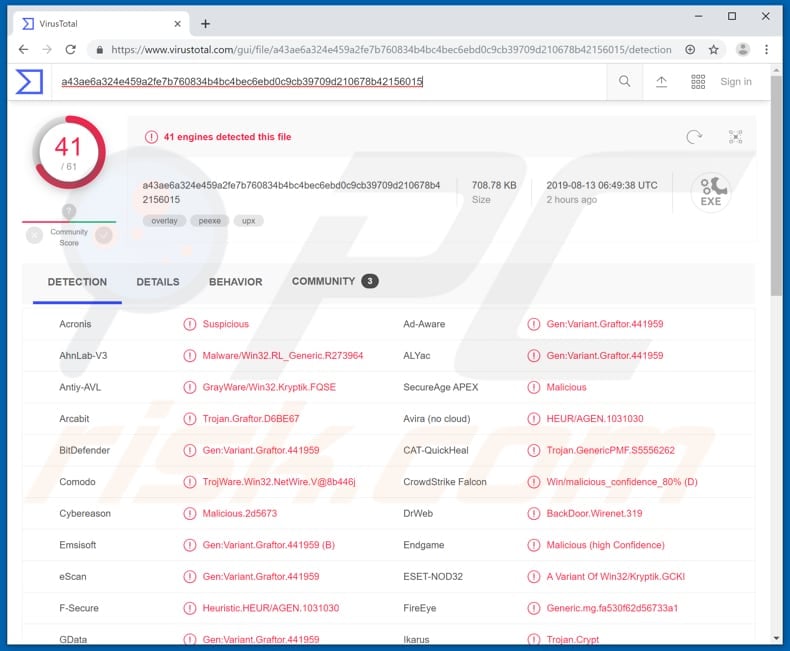
Quasar malware overview
Quasar can be used to access Task Manager, Registry Editor, manage files and startup items, download/upload and execute files, access system information, run various computer commands, log keystrokes, steal passwords and access files stored on the computer. It is a powerful tool that can cause serious problems.
Using Quasar, cyber criminals can access Task Manager and start/end processes, and add programs that run automatically on system startup. Note, the added programs are often malicious. Furthermore, Quasar can be used to download and execute various files.
Cyber criminals can thus infect computers with high-risk malware such as ransomware, trojans or other malicious software. Quasar can operate as a keylogger, since it is capable of recording key presses. This feature is used to steal credentials (logins passwords) of personal, important accounts such as Facebook, email, banking accounts, and so on.
By having access to these accounts, cyber criminals can earn revenue via transactions, purchases, obtaining sensitive information, and so on. In any case, recorded keystrokes can cause serious problems such as financial loss, loss of private information, or access to important accounts.
Furthermore, Quasar is used to shut down or restart the system. This might lead to data loss or other problems. For example, unsaved data in documents or other files might be lost, and so on. This RAT can steal and recover passwords from common browsers such as Google Chrome, Mozilla Firefox, and various FTP clients.
This feature can also steal various important accounts. With access to Registry Editor, cyber criminals who use Quasar can change system and application settings. Note, registry errors can cause a number of problems, including irreversible damage to the operating system.
In summary, Quasar has many functions and, if employed for malicious purposes, can lead to serious issues. Therefore, uninstall this software immediately. Note that this applies only to users who were tricked into installing the program by cyber criminals.
| Name | Quasar remote access trojan |
| Threat Type | Remote access trojan, Password-stealing virus, Banking malware, Spyware |
| Detection Names | Avira (HEUR/AGEN.1031030), BitDefender (Gen:Variant.Graftor.441959), ESET-NOD32 (A Variant Of Win32/Kryptik.GCKI), Kaspersky (HEUR:Trojan.Win32.NetWire.gen), Full List (VirusTotal) |
| Symptoms | Trojans are designed to stealthily infiltrate the victim's computer and remain silent, and thus no particular symptoms are clearly visible on an infected machine. |
| Distribution methods | Infected email attachments, malicious online advertisements, social engineering, software 'cracks', dubious file or software download channels, fake update tools. |
| Damage | Stolen banking information, passwords, identity theft, the victim's computer added to a botnet, installation of various malware. |
| Malware Removal (Windows) |
To eliminate possible malware infections, scan your computer with legitimate antivirus software. Our security researchers recommend using Combo Cleaner. Download Combo CleanerTo use full-featured product, you have to purchase a license for Combo Cleaner. 7 days free trial available. Combo Cleaner is owned and operated by RCS LT, the parent company of PCRisk.com. |
Remote Access Trojan examples
More examples of RATs are Sakula, DarkComet, and FlawedAmmyy. These tools are often used to perform illegal actions (i.e. steal sensitive information and accounts). People with computers infected by RATs often end up experiencing financial, data loss, infections with other malware, and so on. When detected/discovered on the operating system.
How did Quasar infiltrate my computer?
Research shows that cyber criminals proliferate Quasar through spam campaigns and various downloaders (or other dubious download channels). Cyber criminals who use spam campaigns send emails that contain attached files and hope that recipients open them. If opened, the malicious attachments install unwanted, malicious software.
Examples of files that are often used to proliferate malware are Microsoft Office documents, PDF files, executables, JavaScript files, archives such as ZIP, RAR that contain malicious files, and so on. Furthermore, dubious file or software download channels can be used to proliferate malware.
Typically, these are various third party downloaders or installers, unofficial websites, free file hosting websites or freeware download pages, Peer-to-Peer networks (torrent clients, eMule, and so on) and other similar sources. People who open files downloaded from these sources often cause installation of malicious software.
The uploaded files are disguised as harmless and legitimate. Other ways are used to trick people into installing rogue programs including fake update tools, trojans, and unofficial software 'activation' tools. Fake update tools supposedly update software, however, they cause download/installation of other, malicious programs.
They can infect computers by exploiting bugs/flaws of outdated software. Trojans are malicious programs that, once installed, download, install, and proliferate malware. They can only be effective, however, if they are first installed on the system. Unofficial "activators" are used by people who wish to avoid paying for licensed software, however, these tools often proliferate malicious software.
How to avoid installation of malware?
If an email is irrelevant, sent from an unknown, suspicious address, and contains an attachment, handle it carefully. Files attached to these emails of this kind should not be opened. All software should be downloaded from official sources (websites) and no other channels or tools should be trusted.
Update installed software properly: update it with implemented functions or tools created by official software developers. If installed software requires activation, it should not be bypassed using third party activation ('cracking') tools. These are illegal and often used to proliferate and install malicious software.
The operating system can also be protected by regularly scanning it with a reputable anti-virus or anti-spyware suite. If you believe that your computer is already infected, we recommend running a scan with Combo Cleaner Antivirus for Windows to automatically eliminate infiltrated malware.
Screenshot of Quasar administration panel:
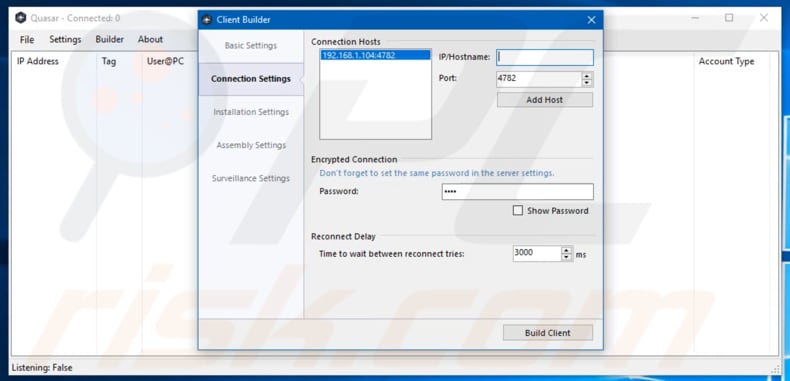
Update August 29, 2019 - Recently, a new spam email campaign distributing the Quasar RAT has been discovered. The campaign presents emails as job application forms and the attachment is usually a Microsoft Word document.
Note, however, that cyber criminals have started using a number of techniques to decrease the chance of being detected by various internet security suites. Firstly, the attachment is password-protected. The email is delivered with a message stating that the attachment is protected with a password, and it also provides this password.
This is done to prevent MS Word from automatically running implemented macros, which can be detected as malicious activity. Furthermore, the macro commands contain hundreds or even thousands of unnecessary ("garbage") base64-encoded code strings.
Cyber criminals inject this random code, since many code analysis tools are likely to crash due to memory overload. Additionally, not all data that is essential to downloading/installing malware is placed in the macro commands. Some information is derived from the metadata of images embedded in the document.
Once the macro runs successfully, user are presented with image(s) displaying an error message, whilst in the background, a malicious self-extracting executable (which contains Quasar RAT's binary file) is downloaded.
Screenshot of the deceptive email:
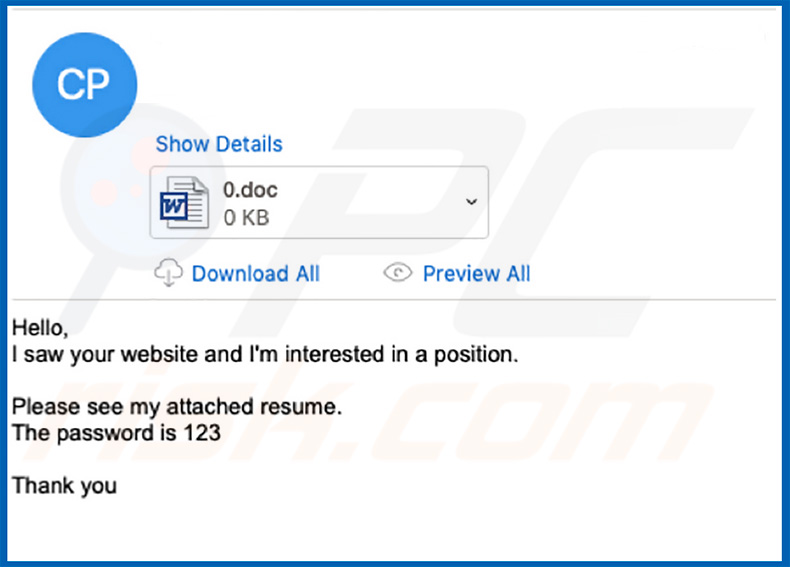
Text presented within this email:
Hello,
I saw your website and I'm interested in a position.
Please see my attached resume.
The password is 123
Thank you
Screenshot of the malicious MS Word attachment:
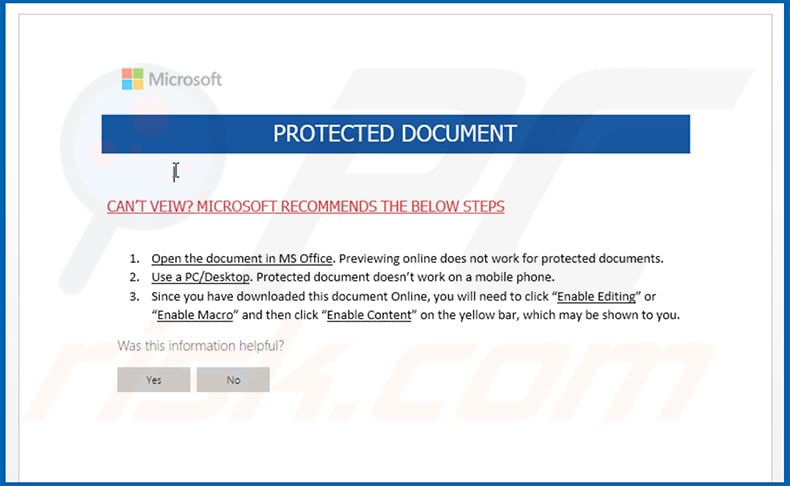
Example of a malicious MS Excel document used to inject Quasar RAT into the system:
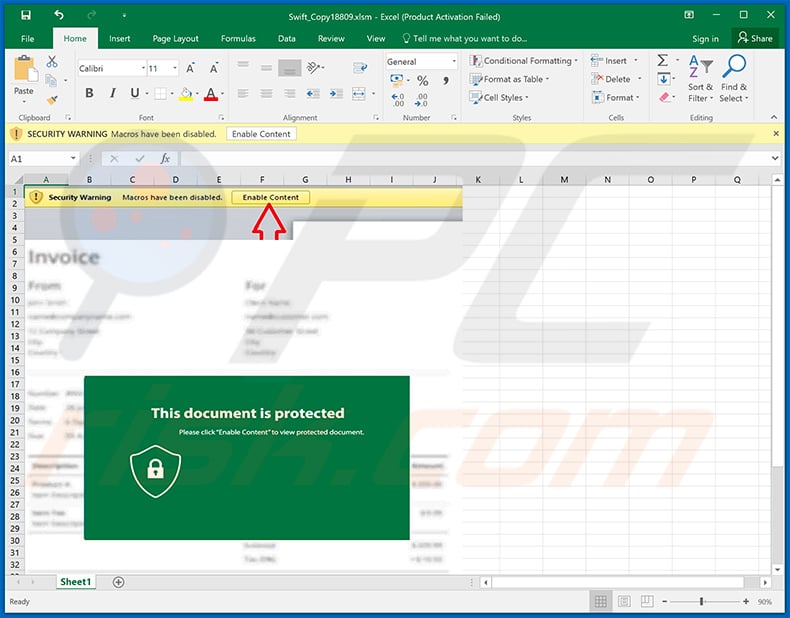
Another example of a spam email used to spread Quasar RAT (the attached PDF document contains a link to download an archive (hosted in Dropbox) with a malicious executable inside):
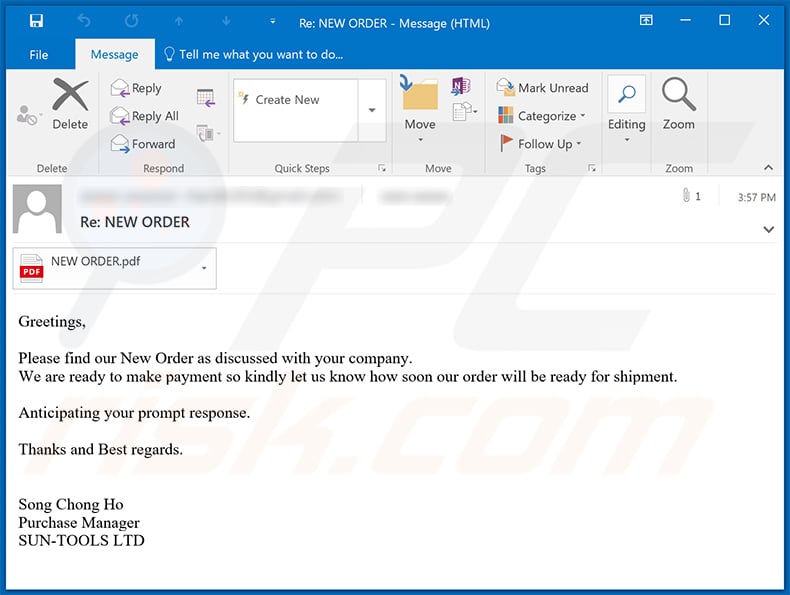
Text presented within:
Subject: Re: NEW ORDER
Greetings,
Please find our New Order as discussed with your company.
We are ready to make payment so kindly let us know how soon our order will be ready for shipment.Anticipating your prompt response.
Thanks and Best regards.
Song Chong Ho
Purchase Manager
SUN-TOOLS LTD
Appearance of Quasar's remote desktop access screen:
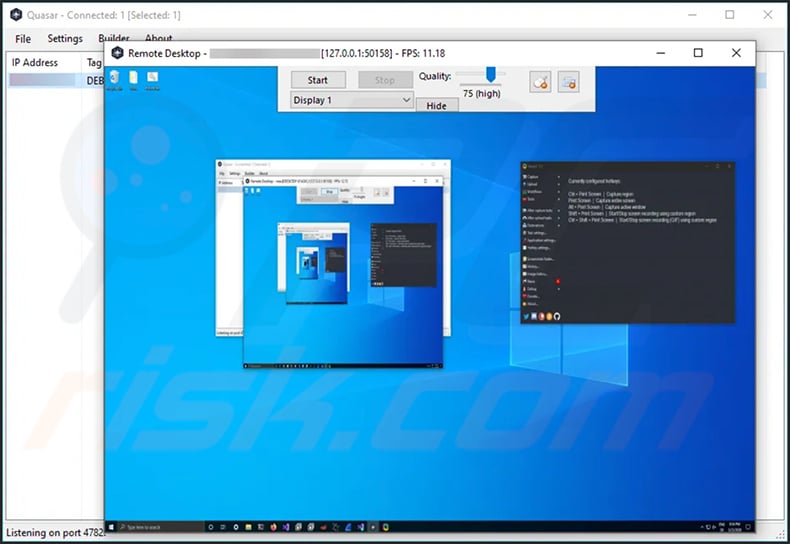
Update February 2, 2025 - A new supply chain attack has been discovered with a malicious npm package ("ethereumvulncontracthandler"). Pretending to detect Ethereum smart contract flaws, it deploys Quasar RAT. The package downloads a malicious script from a remote server, which then runs Quasar RAT on Windows systems.
Instant automatic malware removal:
Manual threat removal might be a lengthy and complicated process that requires advanced IT skills. Combo Cleaner is a professional automatic malware removal tool that is recommended to get rid of malware. Download it by clicking the button below:
DOWNLOAD Combo CleanerBy downloading any software listed on this website you agree to our Privacy Policy and Terms of Use. To use full-featured product, you have to purchase a license for Combo Cleaner. 7 days free trial available. Combo Cleaner is owned and operated by RCS LT, the parent company of PCRisk.com.
Quick menu:
How to remove malware manually?
Manual malware removal is a complicated task - usually it is best to allow antivirus or anti-malware programs to do this automatically. To remove this malware we recommend using Combo Cleaner Antivirus for Windows.
If you wish to remove malware manually, the first step is to identify the name of the malware that you are trying to remove. Here is an example of a suspicious program running on a user's computer:

If you checked the list of programs running on your computer, for example, using task manager, and identified a program that looks suspicious, you should continue with these steps:
 Download a program called Autoruns. This program shows auto-start applications, Registry, and file system locations:
Download a program called Autoruns. This program shows auto-start applications, Registry, and file system locations:

 Restart your computer into Safe Mode:
Restart your computer into Safe Mode:
Windows XP and Windows 7 users: Start your computer in Safe Mode. Click Start, click Shut Down, click Restart, click OK. During your computer start process, press the F8 key on your keyboard multiple times until you see the Windows Advanced Option menu, and then select Safe Mode with Networking from the list.

Video showing how to start Windows 7 in "Safe Mode with Networking":
Windows 8 users: Start Windows 8 is Safe Mode with Networking - Go to Windows 8 Start Screen, type Advanced, in the search results select Settings. Click Advanced startup options, in the opened "General PC Settings" window, select Advanced startup.
Click the "Restart now" button. Your computer will now restart into the "Advanced Startup options menu". Click the "Troubleshoot" button, and then click the "Advanced options" button. In the advanced option screen, click "Startup settings".
Click the "Restart" button. Your PC will restart into the Startup Settings screen. Press F5 to boot in Safe Mode with Networking.

Video showing how to start Windows 8 in "Safe Mode with Networking":
Windows 10 users: Click the Windows logo and select the Power icon. In the opened menu click "Restart" while holding "Shift" button on your keyboard. In the "choose an option" window click on the "Troubleshoot", next select "Advanced options".
In the advanced options menu select "Startup Settings" and click on the "Restart" button. In the following window you should click the "F5" button on your keyboard. This will restart your operating system in safe mode with networking.

Video showing how to start Windows 10 in "Safe Mode with Networking":
 Extract the downloaded archive and run the Autoruns.exe file.
Extract the downloaded archive and run the Autoruns.exe file.

 In the Autoruns application, click "Options" at the top and uncheck "Hide Empty Locations" and "Hide Windows Entries" options. After this procedure, click the "Refresh" icon.
In the Autoruns application, click "Options" at the top and uncheck "Hide Empty Locations" and "Hide Windows Entries" options. After this procedure, click the "Refresh" icon.

 Check the list provided by the Autoruns application and locate the malware file that you want to eliminate.
Check the list provided by the Autoruns application and locate the malware file that you want to eliminate.
You should write down its full path and name. Note that some malware hides process names under legitimate Windows process names. At this stage, it is very important to avoid removing system files. After you locate the suspicious program you wish to remove, right click your mouse over its name and choose "Delete".

After removing the malware through the Autoruns application (this ensures that the malware will not run automatically on the next system startup), you should search for the malware name on your computer. Be sure to enable hidden files and folders before proceeding. If you find the filename of the malware, be sure to remove it.

Reboot your computer in normal mode. Following these steps should remove any malware from your computer. Note that manual threat removal requires advanced computer skills. If you do not have these skills, leave malware removal to antivirus and anti-malware programs.
These steps might not work with advanced malware infections. As always it is best to prevent infection than try to remove malware later. To keep your computer safe, install the latest operating system updates and use antivirus software. To be sure your computer is free of malware infections, we recommend scanning it with Combo Cleaner Antivirus for Windows.
Frequently Asked Questions (FAQ)
My computer is infected with Quasar malware, should I format my storage device to get rid of it?
No, Quasar's removal does not require such drastic measures.
What are the biggest issues that Quasar malware can cause?
Quasar is classified as a RAT (Remote Access Tool/Trojan) - a program designed to enable remote access/control over devices. Hence, it can be variously misused and cause a likewise broad range of problems. Quasar can perform many harmful actions on devices, and it has multiple data-stealing functionalities. Furthermore, this RAT can download/install additional malware. In short, software like Quasar can cause multiple system infections, severe privacy issues, significant financial losses, and identity theft.
What is the purpose of Quasar malware?
Cyber criminals use malware primarily to generate revenue. However, they may also use this software for their own amusement or to disrupt processes (e.g., sites, services, companies, organizations, etc.), accomplish personal grudges, or even launch politically/geopolitically motivated attacks.
How did Quasar malware infiltrate my computer?
The most common malware distribution techniques include: drive-by (stealthy and deceptive) downloads, malicious attachments/links in spam mail, dubious download channels (e.g., freeware and third-party sites, Peer-to-Peer sharing networks, etc.), online scams, illegal software activation tools ("cracks"), and fake updates. Furthermore, some malicious programs are capable of self-spreading via local networks and removable storage devices (e.g., external hard drives, USB flash drives, etc.).
Will Combo Cleaner protect me from malware?
Yes, Combo Cleaner is capable of detecting and eliminating practically all of the known malware infections. It has to be emphasized that performing a complete system scan is essential - since high-end malicious software typically hides deep within systems.
Share:

Tomas Meskauskas
Expert security researcher, professional malware analyst
I am passionate about computer security and technology. I have an experience of over 10 years working in various companies related to computer technical issue solving and Internet security. I have been working as an author and editor for pcrisk.com since 2010. Follow me on Twitter and LinkedIn to stay informed about the latest online security threats.
PCrisk security portal is brought by a company RCS LT.
Joined forces of security researchers help educate computer users about the latest online security threats. More information about the company RCS LT.
Our malware removal guides are free. However, if you want to support us you can send us a donation.
DonatePCrisk security portal is brought by a company RCS LT.
Joined forces of security researchers help educate computer users about the latest online security threats. More information about the company RCS LT.
Our malware removal guides are free. However, if you want to support us you can send us a donation.
Donate
▼ Show Discussion